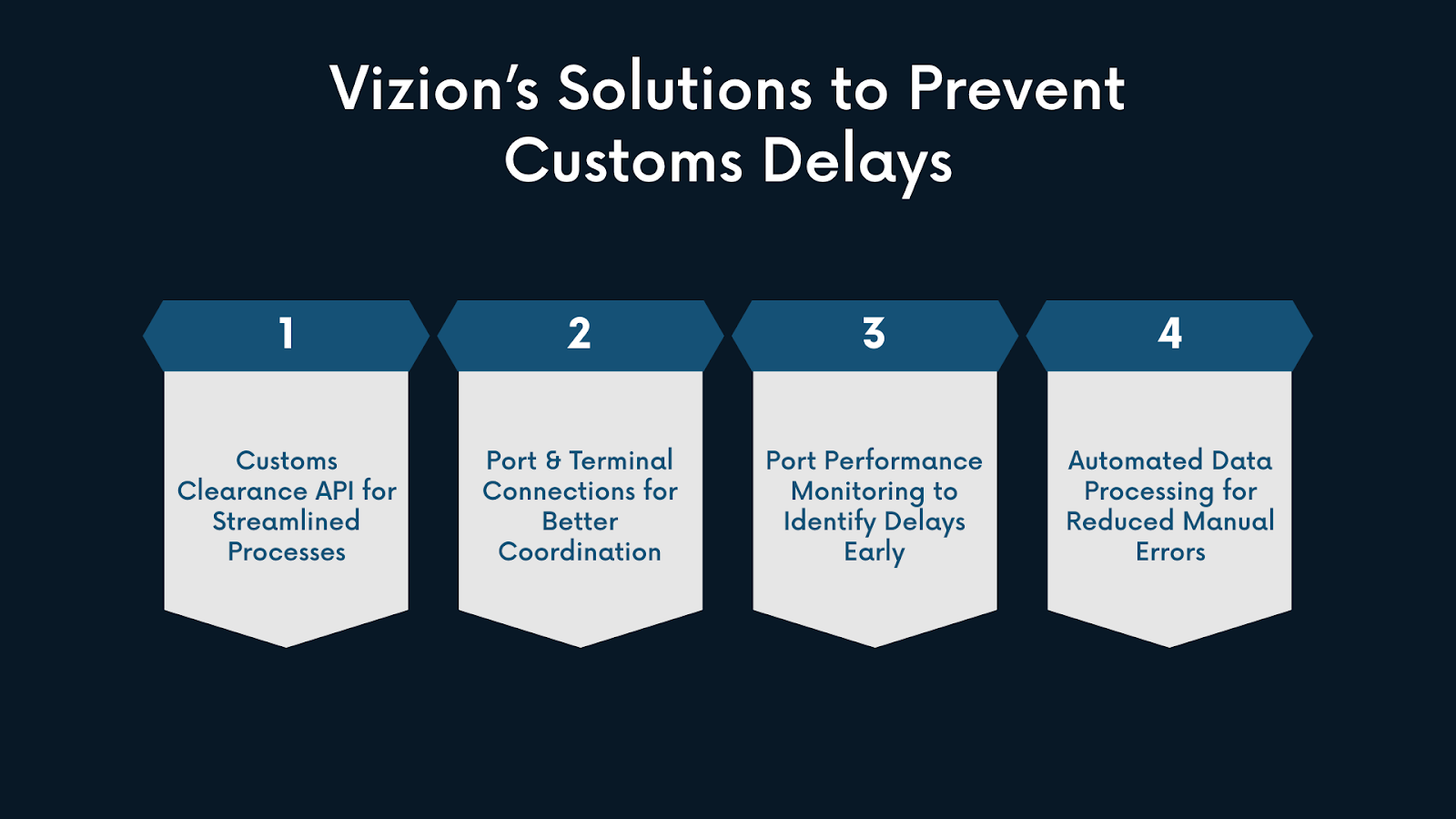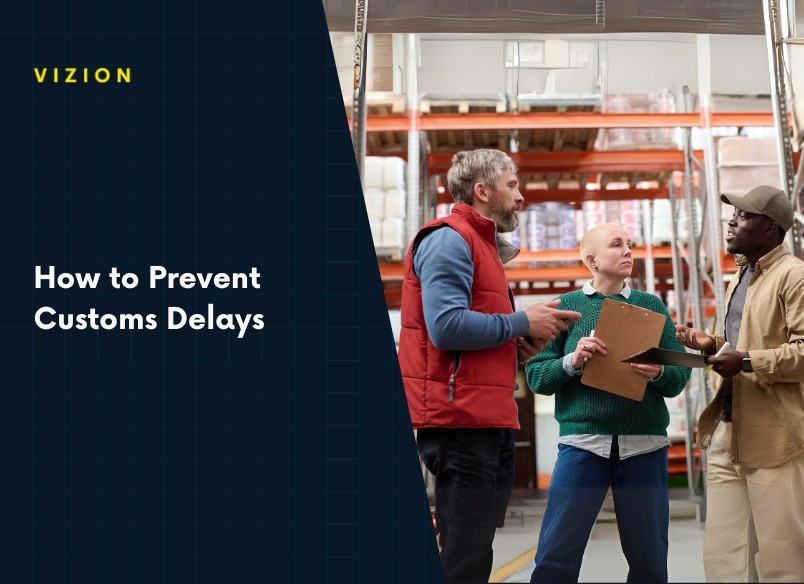Shipping delays caused by customs issues are a significant challenge. A recent study found that 32% of delays are caused by errors or missing information on customs invoices, resulting in costly holdups and disruptions to the supply chain.
To prevent customs delays, businesses must prioritize maintaining accurate documentation, streamlining their processes, and ensuring efficient customs clearance.
Vizion provides real-time tracking and access to up-to-date data, which can significantly enhance the process, ensuring goods move through customs smoothly and without unnecessary hold-ups.
What Are Customs Delays?
Customs delays occur when customs authorities hold up shipments due to missing or incorrect documentation, regulatory issues, or additional inspections. These delays can range from a few hours to several days, depending on the nature of the shipment and the efficiency of the customs process.
Common Causes of Customs Delays

Customs delays are often the result of several factors that can complicate the clearance process. Identifying and addressing these causes early can help businesses prevent significant disruptions to their supply chain.
- Missing or Incorrect Documentation: Incomplete or incorrect customs declarations, commercial invoices, and bills of lading are the most common cause of customs delays. Any missing or inaccurate paperwork can trigger a delay, as customs authorities must resolve discrepancies before clearing the goods.
- Inaccurate Tariff Classifications: Incorrectly classifying goods under the wrong tariff codes can result in delays as authorities reevaluate the shipment.
- Regulatory Compliance Issues: Trade regulations and tariffs are subject to constant change. If shipments do not meet the latest requirements, customs authorities will hold the goods until the necessary compliance issues are resolved.
- Additional Inspections: Random or routine inspections by customs authorities may cause extended delays if the shipment requires further checks or clearance.
- Port Congestion: Busy terminals often experience slower customs processing due to the high volume of shipments. This leads to longer waiting times and slower clearance, ultimately delaying the shipment.
Staying informed about the latest regulatory changes and best practices can help businesses stay ahead of potential compliance issues and streamline the clearance process.
Impact of Customs Delays on Supply Chain
Customs delays can have a domino effect on the entire supply chain, resulting in significant disruptions and increased costs. Customs delays can lead to:
1. Shipping Disruptions
Delays in the customs process push back timelines and affect several key areas, including:
- Missed Delivery Dates: The expected arrival of goods is pushed back, which can disrupt the entire production schedule.
- Inventory Challenges: Delayed shipments create uncertainty in inventory planning, which can lead to stockouts or excess stock.
- Production Delays: Businesses may lack the necessary goods to meet production schedules, thereby delaying downstream processes.
2. Increased Costs
As goods sit at customs, additional charges start to accumulate:
- Demurrage and Detention Fees: Fees charged for containers that stay longer than their allotted time at the port or terminal.
- Storage Costs: If containers are held at a terminal for an extended period, storage fees can accumulate, contributing to the overall shipping cost.
- Lost Profitability: With increasing fees, the cost of shipping rises, affecting the profit margin for each delayed shipment.
3. Customer Satisfaction
Delays also have a direct impact on customer relationships:
- Late Deliveries: Customers receive their goods later than expected, which can harm their trust and satisfaction.
- Loss of Business: Consistent delays can lead customers to seek more reliable suppliers, resulting in lost revenue and damaged reputation.
- Reduced Loyalty: The longer the delays, the harder it becomes to maintain customer loyalty, as timely deliveries are a key factor in customer retention.
Vizion’s Solutions to Prevent Customs Delays

Efficient customs clearance is essential for ensuring goods move smoothly through the supply chain. However, customs delays often stem from issues such as incomplete documentation, regulatory missteps, and a lack of communication between stakeholders.
Vizion offers several solutions that can help businesses prevent these delays and maintain the smooth flow of goods.
1. Customs Clearance API for Streamlined Processes
One of the most common reasons for customs delays is the submission of incomplete or incorrect paperwork, which requires businesses to address issues or resubmit forms manually.
- How Vizion Helps: Vizion's Customs Clearance API streamlines the customs process by automating data exchange between systems, such as ERP and TMS.
This reduces the manual effort needed to manage customs paperwork, improving accuracy and helping to avoid delays. The API ensures that all necessary documentation is submitted on time, thereby reducing the risk of errors that can lead to clearance delays.
2. Port & Terminal Connections for Better Coordination
Port congestion and delays at terminals can hinder the customs clearance process. When terminals are crowded, the processing of shipments can slow down, resulting in delayed customs clearance of goods.
- How Vizion Helps: Vizion’s Port & Terminal Connections provide real-time data on port performance, including key events like the Last Free Date and the status of Available for Pickup.
By providing timely insights into port activity, Vizion helps businesses coordinate better, avoid delays, and reduce detention and demurrage fees. This facilitates smoother customs processing by ensuring that goods move efficiently through terminals.
3. Port Performance Monitoring to Identify Delays Early
Delays at specific ports or terminals can exacerbate delays in customs clearance. If a shipment is delayed at the port, it may not be able to clear customs in a timely manner.
- How Vizion Helps: With Port Performance Monitoring, Vizion tracks the efficiency of ports, identifying the time it takes for vessels to berth and the duration of time containers remain at mooring.
By anticipating delays at specific ports, teams can take preventive actions, like planning alternative routes or ports, to ensure that customs holds are addressed before they impact shipping timelines.
4. Automated Data Processing for Reduced Manual Errors
Manual data entry errors are a common cause of customs delays. Missing or incorrect data often results in incomplete or inaccurate customs declarations, which can lead to delays.
- How Vizion Helps: Vizion automates the data collection and processing for all container-related information, ensuring that submissions are accurate and timely.
With automated webhooks, businesses receive real-time updates on customs-related events, minimizing errors and reducing clearance delays.
By incorporating Vizion’s suite of solutions, businesses can stay ahead of potential customs delays, avoid costly demurrage and detention charges, ensuring that goods are cleared efficiently and continue their journey without significant disruption.
Conclusion
Customs delays can disrupt supply chains, resulting in late deliveries, increased costs, and dissatisfied customers. These delays are often due to missing documentation, regulatory issues, and port congestion. By utilizing technology, businesses can streamline customs clearance and prevent these disruptions.
Vizion’s customs clearance API, automated data processing, and port performance monitoring equip businesses to manage customs delays effectively. With real-time tracking, accurate documentation, and port insights, Vizion helps companies stay ahead of customs challenges and maintain a smooth-running supply chain.
Book a demo with Vizion:
- Real-Time Container Tracking: Access standardized, detailed tracking events via API or UI for up-to-the-minute container data.
- TradeView: Monitor the live flow of any company's shipments 30 to 90 days before arrival at destination and analyze trends across 10 years of historical supplier, product, and logistics movement data. With 900 million shipment records, 140+ attributes per shipment, coverage spanning 190 countries, and comprehensive HS code data, TradeView empowers data-driven decisions that optimize global trade management.
Logistics Performance Hub: Access a comprehensive suite of global logistics datasets, including Port Performance, Port Activity, and Port Pairs, to analyze shipping trends, port throughput, container dwell times, and real-time port activity, enabling smarter decision-making about containerized freight movements.



%20-%202025-12-03T153209.004.png)
%20-%202025-12-03T102433.766.png)
.png)














